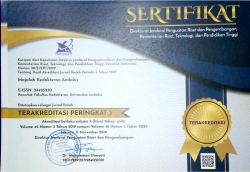The Potential of Bacillus spp. In Green Biosynthesis of Zinc Oxide Nanoparticles
Abstract
Nanopartikel yang dihasilkan melalui metode Green biosintesis berpotensi untuk diterapkan pada dunis medis dan farmasi. Penelitian ini menggunakan senyawa metabolit yang dihasilkan isolat Bacillus spp untuk mereduksi zink sulfat menjadi nanopartikel zink oksida. Berdasarkan hasil pengukuran spetrofotometri UV-Vis panjang gelombang optimum koloid nanopartikel yang dihasilkan dari proses Green biosintesis isolate BES 6A dengan penambahan zink sulfat sebanyak 0,2 g/ml yaitu pada 366 nm. Adapun gugus fungsi Zn-O berdasarkan pengukuran FTIR terbaca pada panjang puncak gelombang 438 dan 530 cm-1. Bentuk kristal yang dihasilkan yaitu heksagonal dengan puncak 2Ɵ yang terdeteksi yaitu 31,82°; 34,33°; 36,49°; 47,56°; 57,16°; 63,20°; 66,76°; dan 68,99° yang menandakan kehadiran nanopartikel zink oksida berdasarkan referensi ICDD 00-001-1136. Ukuran nanopartikel yang dihasilkan yaitu 30 – 47 nm.
Keywords
Full Text:
PDFReferences
Amiri A, Dehkordi R, Heidarnejad M, Dehkordi M. Effect of the zinc oxide nanoparticles and thiamine for the management of diabetes in alloxan induced mice: a stereological and biochemical study. Biol Trace Elem Res. 2018;181:258–64.
Senapati VA, Gupta GS, Pandey AK, Shanker R, Dhawan A, Kumar A. Zinc oxide nanoparticle induced age dependent immunotoxicity in BALB/c mice. Toxicol Res. 2017;6(3):342–52.
Ahmed S, Annu, Chaudhry SA, Ikram S. A review on biogenic synthesis of ZnO nanoparticles using plant extracts and microbes: a prospect towards green chemistry. J Photochem Photobiol B Biol. 2017;166:272–84.
Keat CL, Aziz A, Eid AM, Elmarzugi NA. Biosynthesis of nanoparticles and silver nanoparticles, Bioresour. Bioprocess. 2015;2(1):1–11.
Yusof H, Mohamad R, Zaidan U, Rahman N. Sustainable microbial cell nanofactory for zinc oxide nanoparticles production by zinc-tolerant probiotic Lactobacillus plantarum strain TA4. Microb Cell Fact. 2020;19(10).
Iqtedar M, Riaz H, Kaleem A, Abdullah R, Aihetasham A, Naz S, et al. Biosynthesis, optimization, and characterization of ZnO nanoparticles using Bacillus cereus MN181367 and their antimicrobial activity against multidrug resistant bacteria. Rev Mex Ing Quim. 2020;19(1).
Tiwari V, Mishra N, Gadani K, Solanki PS, Shah NA, Tiwari M. Mechanism of anti-bacterial activity of zinc oxide nanoparticle against carbapenem-resistant acinetobacter baumannii. Front Microbiol. 2018;9.
Balraj B, Senthikumar N, Siva C, Krithikadevi R, Julie A, Potheher I V., et al. Synthesis and characterization of zinc oxide nanoparticles using marine streptomyces sp. with its investigations on anticancer and antibacterial activity. Res Chem Intermed. 2016;42(11).
Saravanan M, Gopinath V, Chaurasia MK, Syed A, Ameen F, Purushothaman N. Green synthesis of anisotropic zinc oxide nanopartices with antibacterial and cytofriendly properties. Microb Pathog. 2018;115:57–63.
Sarina G, Hanifa D, Armenia, Djamaan A. Screening of endophytic bacteria from surian leaves (Toona sinensis (Juss.) M.roem as silver nanoparticles reducing agent. IOSR-JPBS. 2020;15(2):16–22.
Pomastowski P, Krol-Gorniak A, Railean-Plugaru V, Buszewski B. Zinc oxide nanocomposites - Extracellular synthesis, physicochemical characterization and antibacterial potential. Materials (Basel). 2020;13:43–7.
Eltarahony M, Zaki S, El-Kady M, Abd-El-Haleem D. Biosynthesis, characterization of some combined nanoparticles, and its biocide potency against a broad spectrum of pathogens. Hindawi J Nanomater. 2018;2018.
Kundu D, Hazra C, Chatterjee A, Chaudhari A, Mishra S. Extracellular biosynthesis of zinc oxide nanoparticles using Rhodococcus pyridinivorans NT2: multifunctional textile finishing, biosafety evaluation and in vitro drug delivery in colon carcinoma. J Photochem Photobiol B Biol. 2014;140:194–204.
Miri A, Mahdinejad N, Ebrahimy O, Khatami M, Sarani M. Zinc oxide nanoparticles: Biosynthesis, characterization, antifungal, and cytotoxic activity. Mater Sci Eng C. 2019;104.
Khorsand Zak A, Abd Majid WH, Mahmoudian MR, Darroudi M, Yousefi R. Strach-stabilized synthesis of ZnO nanopowders at low temperature and optical properties study. Adv Powder Technol. 2013;24:618–24.
Mahdi ZS, Roshan FT, Nikzad M, Ezoji H. Biosynthesis of zinc oxide nanoparticles using bacteria: a tudy on the characterization and application for electrochemical determination of bisphenol A. Inorg nano-metal Chem. 2020;
Hulkoti N, Taranath T. Biosynthesis of nanoparticles using microbes- a review. Colloids Surf B Biointerfaces. 2014;121:474–83.
Sneha K, Sathishkumar M, Mao J, Kwak I, Yun Y. Corynebacterium glutamicum-mediated crystalization of silver ions through sorption and reduction processes. Chem Eng J. 2010;162:989–96.
Rehman S, Jermy BR, Akhtar S, Borgio JF, Azeez SA, Ravinayagam V, et al. Isolation and characterization of a novel thermophile: Bacillus haynesii, applied for the green synthesis of ZnO nanoparticles. Artif CELLS, NANOMEDICINE, Biotechnol. 2019;47(1):2072–82.
Nobel Surya P., Arul D, Aiswarya D, Perumal P. Extracellular biosynthesis, characterization and cytotoxic effects of zinc oxide nanoparticles synthesized fro the supernatant of probiotic bacterium, Bacillus amyloliquefaciens CS4. Int J Sci Technol Res v. 2019;8(09).





















